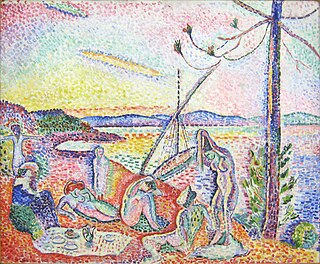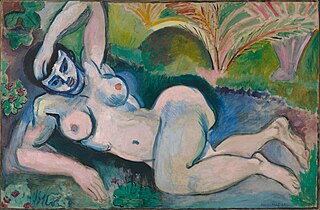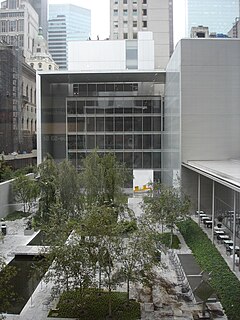
Paul Victor Jules Signac was a French Neo-Impressionist painter who, working with Georges Seurat, helped develop the Pointillist style.

Thomas K. Wesselmann was an American artist associated with the Pop Art movement who worked in painting, collage and sculpture.

Maurice Denis was a French painter, decorative artist and writer, who was an important figure in the transitional period between impressionism and modern art. He was associated with Les Nabis then the Symbolist movement, and then with a return to neo-classicism. His theories contributed to the foundations of cubism, fauvism, and abstract art. Following the First World War, he founded the Ateliers d'Art Sacré, decorated the interiors of churches, and worked for a revival of religious art.

The Société des Artistes Indépendants, Salon des Indépendants was formed in Paris on 29 July 1884. The association began with the organization of massive exhibitions in Paris, choosing the slogan "sans jury ni récompense". Albert Dubois-Pillet, Odilon Redon, Georges Seurat and Paul Signac were among its founders. For the following three decades their annual exhibitions set the trends in art of the early 20th century, along with the Salon d'Automne. This is where artworks were often first displayed and widely discussed. World War I brought a closure to the salon, though the Artistes Indépendants remained active. Since 1920, the headquarters is located in the vast basements of the Grand Palais.

Les Demoiselles d'Avignon is a large oil painting created in 1907 by the Spanish artist Pablo Picasso. The work, part of the permanent collection of the Museum of Modern Art, portrays five nude female prostitutes in a brothel on Calle de Avinyó, a street in Barcelona. Each figure is depicted in a disconcerting confrontational manner and none is conventionally feminine. The women appear slightly menacing and are rendered with angular and disjointed body shapes. The three figures on the left exhibit facial features in the Iberian style of Picasso's native Spain, while the two on the right are shown with African mask-like features. The racial primitivism evoked in these masks, according to Picasso, moved him to "liberate an utterly original artistic style of compelling, even savage force."

Louis Vauxcelles, born Louis Meyer, was an influential French Jewish art critic. He is credited with coining the terms Fauvism (1905), and Cubism (1908).

Albert Marquet was a French painter, associated with the Fauvist movement. He initially became one of the Fauve painters and a lifelong friend of Henri Matisse. Marquet subsequently painted in a more naturalistic style, primarily landscapes, but also several portraits and, between 1910 and 1914, several female nude paintings.
The year 1952 in art involved some significant events and new works.

Blue Nude , an early 1907 oil painting on canvas by Henri Matisse, is located at the Baltimore Museum of Art as part of the Cone Collection.

Henri Matisse’s Jazz is a limited-edition art book containing prints of colorful cut-paper collages, accompanied by the artist's written thoughts. It was first issued on September 30, 1947, by art publisher Tériade. The portfolio, characterized by vibrant colors, poetic texts, and circus and theater themes, marks Matisse's transition to a new form of medium.

Dance is a painting made by Henri Matisse in 1910, at the request of Russian businessman and art collector Sergei Shchukin, who bequeathed the large decorative panel to the Hermitage Museum in Saint Petersburg, Russia. The composition of dancing figures is commonly recognized as "a key point of (Matisse's) career and in the development of modern painting". A preliminary version of the work, sketched by Matisse in 1909 as a study for the work, resides at MoMA in New York City, where it’s been labeled Dance (I).

The nude figure is a tradition in Western art, and has been used to express ideals of male and female beauty and other human qualities. It was a central preoccupation of Ancient Greek art, and after a semi-dormant period in the Middle Ages returned to a central position in Western art with the Renaissance. Athletes, dancers, and warriors are depicted to express human energy and life, and nudes in various poses may express basic or complex emotions such as pathos. In one sense, a nude is a work of fine art that has as its primary subject the unclothed human body, forming a subject genre of art, in the same way as landscapes and still life. Unclothed figures often also play a part in other types of art, such as history painting, including allegorical and religious art, portraiture, or the decorative arts.

The Matisse Museum is a museum in Le Cateau-Cambrésis, France that primarily displays paintings by Henri Matisse. The museum was established by Matisse himself on 8 November 1952; he also defined the way his works should be arranged. At that time the museum was located in the wedding room of the Le Cateau City Hall.

Luxe, Calme et Volupté is an oil painting by the French artist Henri Matisse. Both foundational in the oeuvre of Matisse and a pivotal work in the history of art, Luxe, Calme et Volupté is considered the starting point of Fauvism. This painting is a dynamic and vibrant work created early on in his career as a painter. It displays an evolution of the Neo-Impressionist style mixed with a new conceptual meaning based in fantasy and leisure that had not been seen in works before.
The Piano Lesson depicts the living room of Henri Matisse's home in Issy-les-Moulineaux, with his elder son, Pierre, at the piano, the artist's sculpture Decorative Figure (1908), at bottom left, and, at upper right, his painting Woman on a High Stool. Matisse began with a naturalistic drawing, but he eliminated detail as he worked, scraping down areas and rebuilding them broad fields of color. The painting evokes a specific moment in time—light suddenly turned on in a darkening interior—by the triangle of shadow on the boy's face and the rhyming green triangle of light falling on the garden. The artist's incising on the window frame and stippling on the left side produce a pitted quality that suggests the eroding effects of light or time, a theme reiterated by the presence of the metronome and burning candle on the piano.
Sophie Alexina Victoire Matisse is an American contemporary artist. Matisse initially gained notoriety for her series of Missing Person paintings, in which she appropriated and embellished upon, or subtracted from, recognizable works from art history. Media coverage is often quick to note Sophie Matisse's family background, an art pedigree originating with her great-grandfather, the famous 20th century painter Henri Matisse. Britain's Sunday Telegraph newspaper in 2003 referred to Sophie as "art royalty," a term occasionally paraphrased when discussing Sophie and her artwork.
Lydia Nikolaevna Délectorskaya was a Russian refugee and model best known for her collaboration with Henri Matisse from 1932 onwards.

















